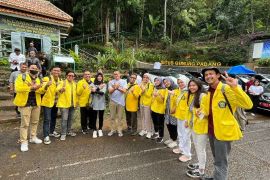Tourism village development includes the aspects of economy, cultural preservation, and environment.
Village governments, through village-owned enterprises (BUMDes), are playing a crucial role in optimizing their tourism potential with professional and sustainable management.
Further, tourism villages have currently emerged as popular destinations among travelers.
According to the Ministry of Tourism, there are four categories of tourism villages. The first is emerging tourism villages — those that have just started operating and are still in the development stage.
These villages usually have great tourism potential, but it is still limited in terms of facilities and activities.
The second category is developing tourism villages, which refers to villages whose potential has started to attract tourists and have good and clear management, with economic activities starting to be generated there.
The third category is developed tourism villages, that is, those that have adequate facilities and infrastructure and have an impact on the improvement of the community's economy.
The fourth category is independent tourism villages, or tourism villages that innovate and attract visitors on a wider scope, including foreign tourists.
The Tourism Village Network data of the Ministry of Tourism pegs the number of tourism villages nationwide at 6,042, as of November 10, 2024.
They comprise 4,703 emerging tourism villages, 992 developing tourism villages, 314 developed tourism villages, and 33 independent tourism villages.
The number of tourism villages reflects an increase of 28.14 percent compared to 4,715 in 2023. The increase is in line with the government's commitment to building sustainable tourism at the village level.
The increase in the number of tourist villages is expected to push up the income of village residents, considering that such villages often encourage the opening of small businesses such as accommodations, food stalls, tourist equipment rental shops, and local souvenir shops, which directly generate additional income for village residents.
The presence of tourism villages also creates new jobs, especially in the services sector, and allows village residents to get additional income.
Development strategy
The development of tourist villages is being carried out using several approaches, including providing skills and management training to the community, building basic infrastructure such as roads and public facilities, as well as assisting in digital-based promotion and marketing.
According to data from the Ministry of Villages and Development of Disadvantaged Regions, as many as 6,584 BUMDes are involved in tourism village management.
The ministry has also directed that village funds be used to support the development of tourism facilities, such as accommodations, tourist information centers, and public areas.
This is expected to make tourist destinations more attractive to tourists and provide a more comfortable experience to visitors.
The government is hoping that, with support from village funds, tourism village development will be faster and meet the needs of the local residents.
The Ministry of Tourism and Creative Economy is also providing Tourism and Creative Economy Business Development Support to 24 tourism villages in 12 provinces as a form of government assistance to improve the quality of tourism villages.
Under the initiative, each tourism village received assistance of Rp120 million (around US$7,511) on average, which was complemented by a business management capacity-building program with financial and business literacy improvement.
Director of financing access at the ministry, Anggara Hayun Anujuprana, said that the Tourism and Creative Economy Business Development Support will encourage tourism village managers to develop the existing potential and increase tourism and creative economy-based micro, small, and medium enterprises (MSMEs) that involve the local community.
Setting an example
Several tourism villages in Indonesia have become models for other developing villages. One of them is Nglanggeran village in Gunungkidul district, Yogyakarta.
The village is known for the Nglanggeran Ancient Volcano and is one of the leading tourist destinations in Yogyakarta.
Through good management, the people of Nglanggeran have succeeded in building homestays, restaurants, and souvenir centers, which have become new sources of income for them.
The village also has a mainstay commodity for export, namely cocoa, which has led to the village often being referred to as the Cocoa Village.
The success of Nglanggeran village in developing community-based tourism has also received international recognition, with the village winning several awards in the tourism sector, including from the United Nations World Tourism Organization (UNWTO).
The formation of the tourism village involved a fairly long process, and the village has gone from experiencing poverty in 1999 to becoming an independent village in 2014.
Nglanggeran achieved independent village status in 2014, marked by an improvement in the welfare of the community and a shift in the community, from being previously oriented toward the agrarian sector to tourism services.
Another example is the renowned Penglipuran village in Bali, which is famous for its cleanliness and beautiful layout.
The village, which has received an award from UNESCO, managed to earn up to Rp25.8 billion in revenue from entrance tickets in 2023.
The village attracts both local and foreign tourists and the development of tourism in the village has helped improve the community's economy through the sale of handicrafts and traditional Balinese food.
Sustainable support from the government, BUMDes, and the participation of local communities are expected to help tourism villages develop as sources of revenue that can improve the quality of life of village residents.
Given their potential, tourism villages are expected to become important pillars for developing sustainable tourism in Indonesia, strengthening the country's position as a tourist destination, and maintaining the uniqueness of its culture and the beauty of its nature.
Related news: Village funds as Indonesia's fuel for developing rural regions
Related news: Village-run enterprises instrumental for rural economy: Minister
Related news: Powering up rural economy with renewable energy
Translator: Zubi Mahrofi, Raka Adji
Editor: Azis Kurmala
Copyright © ANTARA 2024












